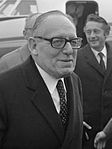French legislative election, 1945
|
|
|||||||||||||||||||||||||||||||||
|---|---|---|---|---|---|---|---|---|---|---|---|---|---|---|---|---|---|---|---|---|---|---|---|---|---|---|---|---|---|---|---|---|---|
|
|||||||||||||||||||||||||||||||||
|
All 522 seats to the French National Assembly 262 seats were needed for a majority |
|||||||||||||||||||||||||||||||||
|
|||||||||||||||||||||||||||||||||
|
|||||||||||||||||||||||||||||||||
Legislative elections were held in France on 21 October 1945 to elect a Constituent Assembly to draft a constitution for a Fourth French Republic. 79.83% of voters participated. Women and soldiers were allowed to vote. 522 seats were elected through proportional representation.
On 21 October 1945, the French voters were called to make two choices: the election of their deputies and a referendum in order to authorize the elected National Assembly to prepare a new constitutional text. De Gaulle and the "Three parties alliance" called for a "Yes" vote, whereas the Radicals and the Conservatives campaigned for a "No".
Symbol of the French Resistance to the German occupation and founder of the Free French Forces General Charles de Gaulle led a provisional government composed of the three main political forces of the Resistance: the French Communist Party (PCF), the French Section of the Workers' International (socialists, SFIO) and the Christian democratic Popular Republican Movement (MRP). It advocated an economic policy inspired by the programme of the National Council of Resistance: the creation of a Welfare State, and the nationalization of banks and major industrial companies (such as Renault). The opposition was composed of the parties which had dominated the pre-war governments of the Third Republic: the Radical Party and the classical Right.
...
Wikipedia



